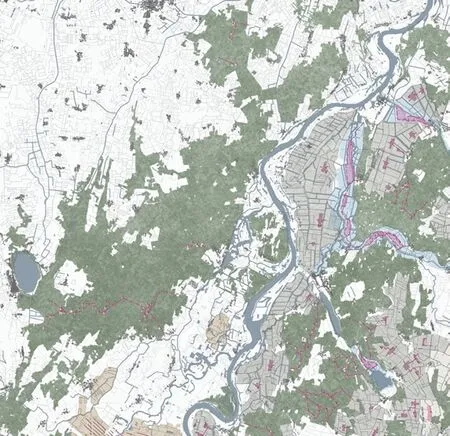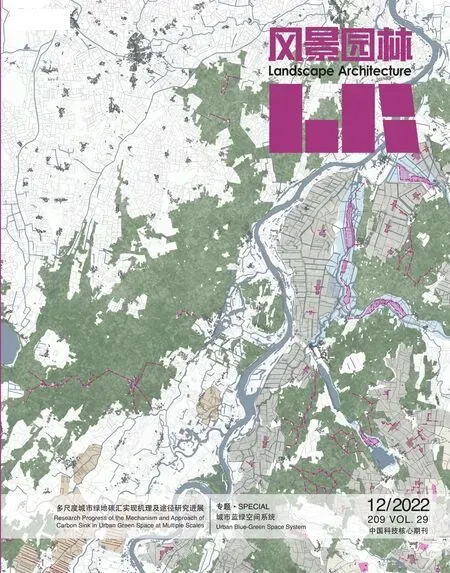城市蓝绿空间系统

蓝绿空间系统反映了自然的演替和时空发展中人类对城市与自然的不断干预。蓝绿空间保证了把自然带到城市,这对人们来说非常重要。因为无论身在何处,人都要与自然建立联系,确保生活质量,以满足人类的基本需求。
奥姆斯特德(Olmsted)在波士顿的翡翠项链设计中,梳理了泥泞的河流系统,为水、沼泽地和低地提供了空间,这是一个适应气候变化的范式。而后,在规划中央公园时,奥姆斯特德和沃克斯(Vaux)检查了曼哈顿岛的地质层,没有对原生景观进行过多改造,只增加了道路、水库和湖泊,而公园外,曼哈顿原始地貌则被夷为平地,为城市网格让路。自19世纪末以来的发展,奥姆斯特德推动了城市公园与绿地系统建设,绿化了城市。随着工业化和城市化的快速发展,伊恩·麦克哈格(Ian Lennox McHarg)认为土地上开放空间的分布必须要反映自然的演进过程,这一点对任何大都市地区来说,不管其位置如何,都是适用的,并倡导在区域范围内结合自然进行设计。随着后工业化以及城市更新的推进,科纳(James Corner)强调了对景观过程的管理,要建立对蓝绿空间长期适应性发展战略。
事实上,由绿色空间和水域空间组成的蓝绿空间系统作为一个相互交织的整体,不仅成为多尺度下生态基础设施网络构建的基础,而且是促进城市自然体系发展,提高城市韧性与增强生命力的重要保障。在这一基础上,中、西方对于蓝绿空间系统的认知,有着十分一致的看法,那就是对“结构”的发现、感知、把握和应用。这种结构存在于每个人的身边,特别是从飞机上鸟瞰某个城市时,熟悉的山水关系和大尺度的蓝绿结构便会印刻在我们的脑海中,例如群山中的杭州西湖景观、河网密布的纽约哈德逊河谷景观、阿尔卑斯山脚下慕尼黑伊萨河谷景观和伦敦泰晤士河及其平原景观。
人类对这种空间图式关系并不陌生,在不同文化背景下,人们也对这一关系有着各自独特的理解。中国人善于在人工聚落中营建自然系统,创造诗意的栖居环境。“寻幽探胜”寄托了中国人对山水的向往和探索,“仁者乐山,智者乐水”体现了中国山水文化中物质性与精神性的高度统一。而在现代社会中,随着城市空间的开发与建设,如何把对山水体系的再塑造融合到城市重要的蓝绿空间系统中,已成为中国风景园林师面临的巨大挑战和理应承担的重要任务。同样,西方人也认可这种动态的自然与人工体系,欧洲学者将这一连贯、完整的城市系统看作一种蓝绿空间相互融合的巨大“多孔结构”,它空间形态多样、组织方式灵活,具有明显的空间渗透性、包容性和结构识别性。英国风景园林师汤姆·特纳(Tom Turner)认为无论从人的心理和身体,城市和乡村,还是空间交织和分离的角度分析,未来的城市将会是一系列无限的景观,这与建筑师克里斯托弗·亚历山大(Christopher Alexander)理解的“城市不是一棵树,它是一种景观”观点相似,不断发展和演替的蓝绿空间系统是最能体现城市空间开放性、动态性、文化性和生态性的景观网络。
在围绕蓝绿空间的研究中,可以看出它们与大都市的发展形式和开放空间的分布形式有着最密切的关系。麦克哈格证明了对蓝绿空间系统的建设,其问题不在于绝对面积的多少,而在于如何分布。作为能够充分反映自然演进过程的复杂系统,蓝绿空间相互耦合形成的综合体,应具有整体性特征,必须在规划中进行理性、综合的考虑,深刻遵循自然的规律,以系统观的生态手段应对自然灾害,构建更加韧性和具有生命力的蓝绿空间系统,让整个城市的资源调配在这个系统中高效地运转。在国土空间范畴下,它是每一个风景园林师都应面对和处理的复杂系统。

Urban Blue-Green Space System
The blue-green space system maps continuous human interventions in cities and the nature during the natural evolution and spatiotemporal development. The blue-green space ensures the availability of nature to cities, which is critical for human beings, because it is important to be able to establish connection with the nature and guarantee the quality of life, so as to meet basic needs of humans, no matter where they reside.
In the design of Boston’s Emerald Necklace, Olmsted analyzed muddy river systems to provide space for water, marshes and lowlands, formulating a paradigm for adapting to climate change. And afterwards, when planning the Central Park, Olmsted and Vaux examined the geological layers of Manhattan Island and decided not to modify its native landscape too much. Rather, they added only some roads, reservoirs and lakes. While outside the park, the original Manhattan landscape was razed to make way for the urban grids. In the development since the late 19th century,Olmsted has promoted the creation of urban systems for parks and green spaces and greened the cities. Ian Lennox McHarg maintains that with rapid industrialization and urbanization, the distribution of open space on the land shall echo the evolution of nature. This idea holds true for any metropolitan area, regardless of its location. And he also advocated designs in combination with the nature on a regional scale. With the advancement in postindustrialization and urban renewal, James Corner emphasizes the management of landscape processes, purposed to frame a longterm adaptive development strategy for the blue-green space.
In fact, composed of green space and water space, the bluegreen space system is an interwoven entity, not only becoming a foundation for the construction of ecological infrastructure networks at multiple scales, but also forming an important guarantee to facilitate the development of urban natural systems and boost the resilience and vitality of cities. On this basis,Eastern and Western scholars reach a very consistent view on the cognition of the blue-green space system—the discovery,perception, understanding and application of “structures,” which exist around everyone. Especially when we get a bird’s eye view of a city from an airplane, the familiar landscape relationship and large-scale blue-green structures would be imprinted in our mind, for example: the West Lake landscape in Hangzhou amid mountains; the Hudson River Valley landscape in New York, with a dense network of rivers; the Isar Valley landscape in Munich at the foot of the Alps; and the Thames River and its plains landscape in London.
Humans are no strangers to such spatial patterning relationship, of which people hold their own unique understanding under different cultural contexts. Chinese are good at constructing natural systems in artificial settlements, so as to create poetic living environment. “Search for seclusion and beautiful scenery” embodies the Chinese people’s aspiration and exploration of landscapes; and “Wise men enjoy water while benevolent ones enjoy mountains” reflects the high degree of unity between materiality and spirituality in Chinese landscape cultures. In modern societies, however, with the development and construction of urban space, it has become a great challenge and surely an important task for Chinese landscape architects to reshape and integrate the landscape system into the significant blue-green space system in cities. Similarly, Westerners also recognize this kind of dynamic natural-artificial system. In fact,European scholars regard such coherent and holistic urban system as a huge “porous structure”, with blue and green spaces converging with each other. This structure is spatially diverse,featuring flexible organizational forms as well as remarkable spatial permeability, inclusiveness and structural identifiability.According to British landscape architect Tom Turner, the future city will be an infinite series of landscapes, whether analyzed from the perspective of human psychology and body, or from that of urban and rural areas, or from that of spatial interweaving and separation. This argument is similar to a viewpoint held by architect Christopher Alexander: “A City is not a tree, it is a landscape.” With this understanding, the constantly developing and evolving blue-green space system becomes a landscape network that can best demonstrate the openness, dynamism,culture and ecology of urban space.
The studies related to the blue-green space are most closely associated with the forms of metropolitan development and the distribution of open spaces. Ian Lennox McHarg has demonstrated that the problem with the construction of the bluegreen space system lies not in the absolute amount of areas, but on how they are distributed. As a complex system that can fully showcase the natural evolution process, the blue and green spaces couple with each other to form a synthesis. Therefore, its holistic characteristics shall be weighed in a rational and comprehensive manner in the planning process by profoundly following the laws of nature, so as to respond to natural disasters with ecological means of systematic views and build up a more resilient and vital blue-green space system. In this system, the entire resource deployment of a city can functioning properly in high efficiency.It is a complicated system that every landscape architect has to face and deal with in the domain of territorial land.
Editor-in-Chief: Professor ZHENG Xi
December 3, 2022

